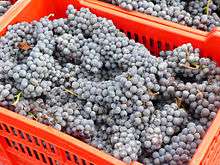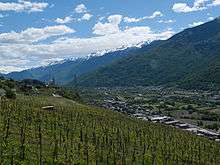Brugnola
Brugnola is a red Italian wine grape variety that is grown in the Lombardy wine region of Valtellina. While historically, Brugnola was thought to be a local synonym for Emilia-Romagna wine grape Fortana, DNA analysis has shown that the two grapes are distinct variety and that, instead, Brugnola shares a close genetic relationship with the Piedmont wine grape Nebbiolo.[1]
Today, Brugnola is a permitted grape variety in the Denominazione di Origine Controllata e Garantita (DOCG) of Valtellina Superiore with the grape most often seen from the Valtellina subzone of Grumello.[1]
History

Brugnola was long thought to be a local synonym used in the Valtellina region for the red Emilia-Romagna grape, Fortana. Even as recently as the 2000 census, plantings of Brugnola in Lombardy were officially counted as part of Fortana's 1,109 hectares (2,740 acres) planted throughout Italy. In the early 21st century, DNA analysis revealed that Brugnola and Fortana were distinct varieties but that Brugnola shared a close parent-offspring relationship with the Piemontese wine grape Nebbiolo, known locally as Chiavennasca.[1]
Relationship to other grapes
Through its parent-offspring relationship with Nebbiolo, Brugnola is a half-sibling of several Piemontese wine grape varieties including: Bubbierasco, Vespolina, Freisa, Nebbiolo rosé, Negretta, Neretto di Bairo and Rossola nera.[2]
Viticulture
In Lombardy, Brugnola is noted for producing reliable yields and its strong resistance to the viticultural hazards of downy mildew and botrytis bunch rot. However, the vine is very prone to damage caused by the onset of powdery mildew late in the growing season.[1]
Wine regions

While Brugnola was still officially considered only a synonym of Fortana in the 2000 Italian census, nearly all of the plantings of Brugnola in the Valtellina region are believed to be actual Brugnola plantings. The grape is a permitted blending variety in several of the red wines of Valtellina, most notably the DOCG wines of Valtellina Superiore-Grumello. Here is it blended with both Nebbiolo (Chiavennasca) as well as Rossola nera.[1]
Synonyms
The Vitis International Variety Catalogue (VIVC) still officially recognizes Brugnola only as a synonym for Fortana[3] and for Lambruscone.[4]
References
- J. Robinson, J. Harding and J. Vouillamoz Wine Grapes - A complete guide to 1,368 vine varieties, including their origins and flavours pgs 138 & 363 Allen Lane 2012 ISBN 978-1-846-14446-2
- Ian D'Agata Native Wine Grapes of Italy, pg 476 University of California Press 2014 ISBN 9780520272262
- Vitis International Variety Catalogue (VIVC) Fortana Archived 2014-02-22 at the Wayback Machine Accessed: February 18th, 2014
- Vitis International Variety Catalogue (VIVC) Lambruscone Archived 2014-02-22 at the Wayback Machine Accessed: February 18th, 2014